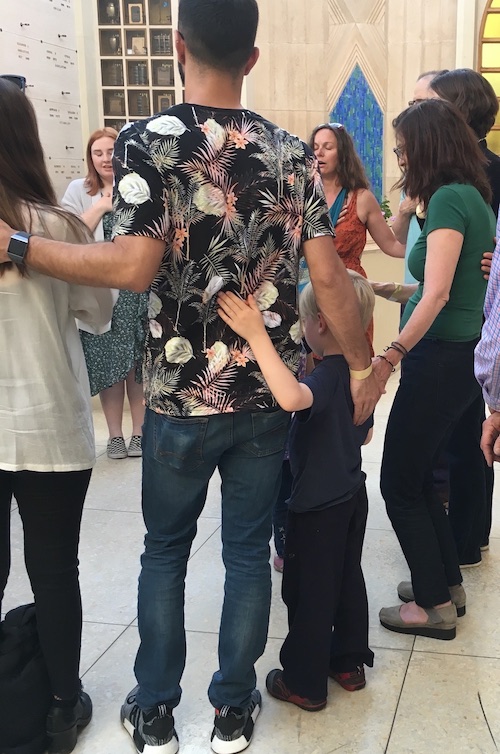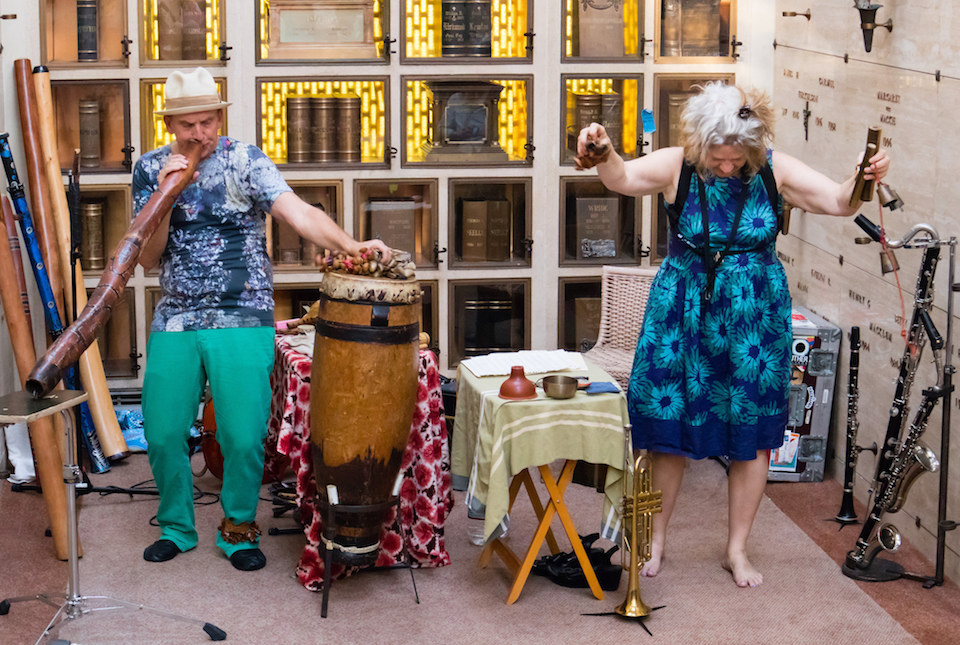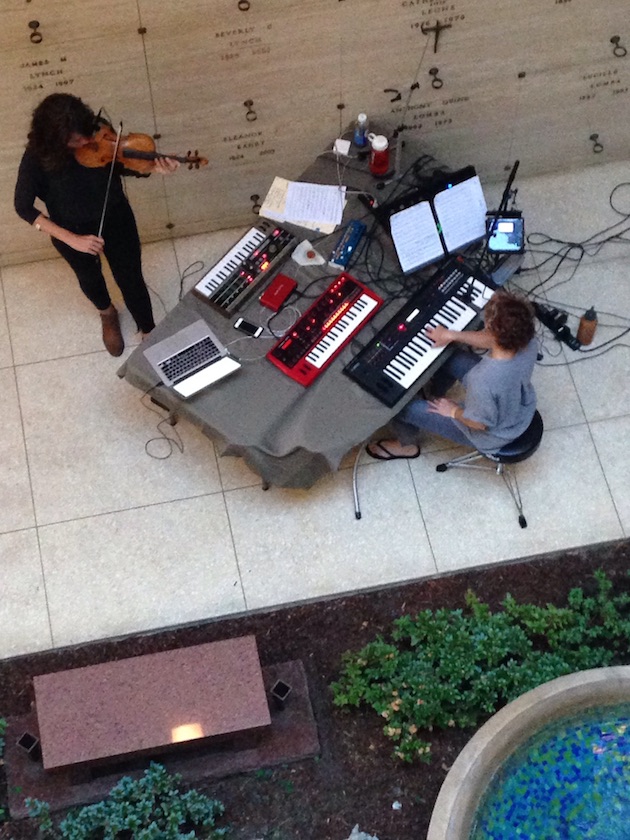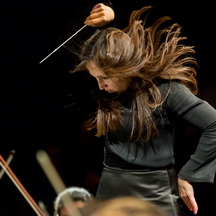A musical party for young and old
The longest day of the year, June 21, has been celebrated by avant garde and experimental musicians at Oakland’s Chapel of the Chimes since 1996. This past Thursday there were 48 separate events that shared the chapels and rooms of this unusual space, some of them solo composer/performers, many duos and several large groups.
Titled, “Garden of Memory,” this acknowledgment of the summer solstice was created by Sarah Cahill, a remarkable pianist and long-time advocate for new music, and ran from 5 p.m. to 9 p.m., ending with hundreds of people tinkling bells and chanting away the first evening of summer.
Built on a hillside by Julia Morgan, the columbarium descends in three main layers, with skylights filtering light down into stone and glass alcoves, chapels, and inner gardens, and then spills out onto upper Piedmont Ave.
We entered at the top, greeted by the popsicle harmonies of Daniel Plonsey and Googleplex, where big band meets improv hurdy gurdy. There was a generous crowd of the faithful and the curious, and I recognized many musicians and not a few composers. This solstice party is designed to be family-friendly, with the audience wandering through the performances and lingering on whim.
So this year we took our six-year-old grandson so that he could experience the extraordinary range of new music and perhaps join in celebration. “It is ‘popsicle’ music because it is fun and surprising, just like cold ice cream,” I said to Teagan, making up a feeling to fit the mood.
“What do you want to see first?” I leaned down and asked.
“I have to go to the bathroom,” he replied.
Christiane and I exchanged a look, and then I recalled that the bathrooms were on the far end at the very bottom, so we three held hands and threaded our way through the crowds past a beguiling variety of experimenters. Actually, this was a good way to get a quick sense, and then afterwards we took our time climbing back up through the levels.
We passed by an ethereal hum of chanters, past the pop and whistle of electronic arrays, and through vocals, strings and saxes.
After a quickly moving line into a pair of unisex bathrooms (originally his and hers, and yes, there was some grumbling from one man in line and a sharp reply by the woman in front of him), we squeezed into the large Chimes Chapel. There, the women’s a capella group Kitka was deftly weaving its magic.
As we entered and crouched down almost onstage, alto Jan Kutulas anchored a mezzo and soprano, the three building soft minor triads that soared into high harmonies and then swelled into a suddenly Big sound that shook the high stone walls. They backed off into a hum.

Shira Cion stepped forward and delivered dense nasal vowels and sharp calls to introduce the next piece, and the other eight singers leaned in for the chorus. The singers were outfitted in brightly patterned smocks, village-y and modern.
We edged back out, and I asked Teagan if he liked those harmonies.
He looked at me, and furrowed his brow. “I’m thirsty,” he finally said. We decided to more slowly wend our way back up and get a water bottle out of the car.
In the other main chapel composer Paul Dresher and percussionist Joel Davel were hunched over their Long Stringed Instrument, teasing out quick patters and thick electronic notes. “They built that instrument themselves,” I told Teagan.
He looked impressed.

Then Amy X. Neuberg took the stage and built clouds of sound by layering tracks. She began by brushing her teeth next to the microphone. Christiane picked Teagan up to stand on the bench next to her so he could watch Amy X turn that shsh… shsh…shsh into a rhythm track like the swish of brush on snare. She added layers that grumbled or sparkled, as surprising as the building that we explored, then sang her lyrics in a high soprano over the top. Those lyrics were thoughtful and a little raunchy, and luckily passed right over our grandson’s blond head.
We stopped off after a tiny winding staircase to hear Soriah singing Tuvan throat singing into a microphone. His delivery was startling and rich, all mud and gravel, and filled the small chapel with an arresting beauty.
“That was different, wasn’t it?” I asked Teagan.
“He sounds like a frog burping,” Teagan pronounced happily. I think he enjoyed it as something new, and he definitely liked the bright harpsichord playing of Faythe Vollrath, with modern writing for a genteel instrument.

At the top we came on a ring of people next to a railing, each holding their right hand on their own chest and their left on the back of the person next to them, the heart chant of the Carnelius Cardew Choir. I asked Teagan if he wanted to join in. After a moment he nodded, and I lifted his left hand high up to the back of a gentleman who was holding a note with his eyes closed. He looked over and then, surprised, down, and smiled at Teagan. The woman to his right placed her hand on Teagan’s back and lifted his hand onto his chest. “Close your eyes and feel the sound,” I told him.

After a while he was ready to move on, and we came to a deep nook with Beth Custer on soprano sax and Stephen Kent on didgeridoo. We sat by the wall, Teagan leaning on my knees, and listened to Kent’s explosive chuffs and keyless tuning and the meditative circular breathing of didgeridoo. Custer’s eye were closed as she pulled fat notes from her sax to add modern arc and intent to Kent’s ancient Australian instrument.
We sat there for a long time, and left when people clapped.
We peered down from above to see violinist Kristina Dutton and vocalist/keyboard Majel Connery (Hae Voces), inprovising on color pencil drawings as their scores, enjoying the waves of sound coming through the floor, and then wandered back outside for the big  sweeping sounds of Orchestra Nostalgico. Their 1920s swamp mambo swayed the crowd, and then they segued into a Charleston. People were dancing.
sweeping sounds of Orchestra Nostalgico. Their 1920s swamp mambo swayed the crowd, and then they segued into a Charleston. People were dancing.
It was finally sunset and someone started to ring a bell. Then bells were ringing everywhere and people were singing all around us. Teagan held his hands over his ears as we made our way out.
“That party was too noisy for my ears!” he complained.
“Did you like it?” I asked him.
He looked thoughtful, then asked, “What’s for dinner?”
I think that went well.
—Adam Broner
Photos from top: Members of Kitka, photo by Tomas Pacha; Amy X, photo by Yolanda Accinelli; Cardew Choir welcomes a new member, photo by Christiane Broner; Stephen Kent and Beth Custer; Hae Voces, photo by Adam Broner.
